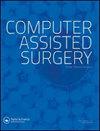Control system design for a novel minimally invasive surgical robot
IF 1.9
4区 医学
Q3 SURGERY
引用次数: 5
Abstract
Abstract A novel separate robotic system for minimally invasive surgery (MIS) has been presented in this paper. Control system architectures were designed, basing on versatile performance criteria. The compact control and mechanical structure were suitable for medical environment. Function and safety design satisfying medical application were integrated into the robot system as well. Additionally, intuitive control algorithm solved the problems of hand-eye incoordination and workspace mismatch between master hands and slave arms during the master–slave control process. A series of experiments have been accomplished to evaluate the performance of the robotic system at last. The results demonstrated that the robotic system was capable of executing surgical operation intuitively and implementing auxiliary functions perfectly, which meant that the control system was feasible and reliable.一种新型微创手术机器人的控制系统设计
摘要:本文提出了一种新型的独立微创手术机器人系统。基于通用性能标准,设计了控制系统架构。紧凑的控制和机械结构适合于医疗环境。将满足医疗应用的功能和安全设计融入到机器人系统中。此外,直观控制算法还解决了主从控制过程中存在的手眼不协调、主从臂工作空间不匹配等问题。最后完成了一系列的实验来评估机器人系统的性能。结果表明,该机器人系统能够直观地执行手术操作,并能较好地实现辅助功能,说明该控制系统可行、可靠。
本文章由计算机程序翻译,如有差异,请以英文原文为准。
求助全文
约1分钟内获得全文
求助全文
来源期刊

Computer Assisted Surgery
Medicine-Surgery
CiteScore
2.30
自引率
0.00%
发文量
13
审稿时长
10 weeks
期刊介绍:
omputer Assisted Surgery aims to improve patient care by advancing the utilization of computers during treatment; to evaluate the benefits and risks associated with the integration of advanced digital technologies into surgical practice; to disseminate clinical and basic research relevant to stereotactic surgery, minimal access surgery, endoscopy, and surgical robotics; to encourage interdisciplinary collaboration between engineers and physicians in developing new concepts and applications; to educate clinicians about the principles and techniques of computer assisted surgery and therapeutics; and to serve the international scientific community as a medium for the transfer of new information relating to theory, research, and practice in biomedical imaging and the surgical specialties.
The scope of Computer Assisted Surgery encompasses all fields within surgery, as well as biomedical imaging and instrumentation, and digital technology employed as an adjunct to imaging in diagnosis, therapeutics, and surgery. Topics featured include frameless as well as conventional stereotactic procedures, surgery guided by intraoperative ultrasound or magnetic resonance imaging, image guided focused irradiation, robotic surgery, and any therapeutic interventions performed with the use of digital imaging technology.
 求助内容:
求助内容: 应助结果提醒方式:
应助结果提醒方式:


